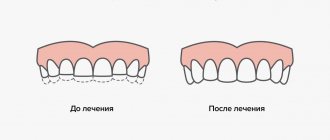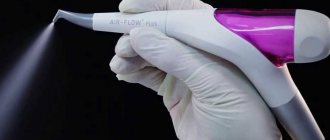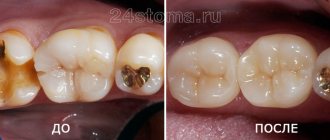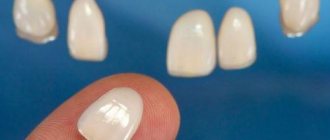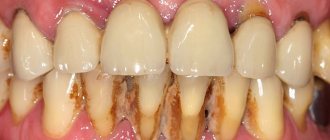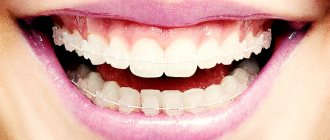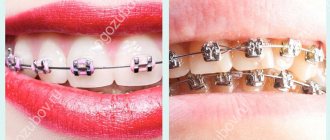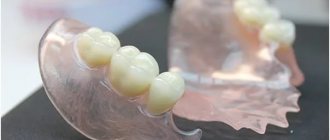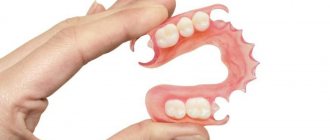01/22/2019 Modern dentistry offers various methods for correcting chips, cracks and other dental defects. One of the popular solutions is extension, which allows you to return the tooth to its original color and shape. What the procedure is and who it is suitable for - you will learn about this from our article.
- What is tooth augmentation?
- Indications and contraindications for the procedure
- Advantages and disadvantages of dental extensions
- Basic methods of filling
- Installation of veneers
- Installation of crowns
- Extension on a pin
What is tooth augmentation?
Dental augmentation is a dental procedure that allows you to restore the appearance of teeth and restore their lost functionality. A type of extension is artistic restoration - a technique for restoring the front teeth.
Both procedures are performed using special materials that are visually similar to the texture of natural enamel. The restored unit has the same shade and texture as natural dental tissue, is highly durable and lasts for at least 10 years.
Indications and contraindications for the procedure
Extension is indicated in the following cases:
- Chips and cracks on the tooth surface.
- Destruction of enamel or its discoloration, which cannot be eliminated with bleaching.
- Partial tooth loss due to injury or caries.
- Malocclusion.
- Interdental gaps.
- Age-related wear of enamel, in which the dental unit darkens and becomes sensitive to external influences.
However, restoration is not suitable for every patient. It cannot be performed if one of the contraindications is present:
- Untreated caries or gum disease.
- Severe systemic diseases, such as blood diseases or diabetes.
- Some mental disorders.
- Bruxism.
- Bruxism. Individual intolerance to the components of the filling composite.
There are also technological limitations: if it is impossible to protect the restored surface from contact with moisture (for example, saliva), then the extension will have to be abandoned - the filling will not harden. Also, some methods cannot be used for dental treatment in children - for example, they do not have pins installed. For most patients, augmentation remains the optimal solution for restoring a lost tooth fragment.
How to do oral hygiene
If it is impossible to refuse drinks and foods that stain filling materials, you need to pay increased attention to hygiene. In such situations, cleaning after every meal is mandatory.
- cleaning in the morning and evening (before and after breakfast, as well as after the last meal) with a medium-hard brush,
- irrigator, dental floss, brushes and rinse for cleaning the interdental spaces after each meal and even after a regular snack.
Advantages and disadvantages of dental extensions
In dentistry, various methods are used to restore lost tooth fragments, but for most patients, doctors recommend paying attention to tooth extensions. This is due to the numerous advantages of the procedure:
- A large selection of technologies and materials allows you to choose the optimal solution for each person and restore both front and back teeth.
- Highly aesthetic results.
- The restoration does not affect neighboring (healthy) units, does not increase the chewing load, that is, it protects the dentition from accelerated wear and destruction.
- Minimal trauma: oral tissues heal quickly without causing significant discomfort to the patient.
- The materials used during extensions are durable, aesthetically pleasing, do not change color and strength during use.
Dental extensions have virtually no disadvantages. The only drawback is the fairly high cost of services, but it can be adjusted by choosing simpler restoration methods and more affordable materials.
Application area
The teeth extension procedure is carried out for adults and children, and the age characteristics and current condition of the patient’s oral cavity are necessarily taken into account. With the help of extensions, you can correct congenital defects in the position of the dentition, as well as eliminate the consequences of tooth decay. In addition, when building up, persistent color changes in tooth enamel are eliminated.
Basic methods
There are several methods of teeth extension, differing in technology, compositions used, and price. The main methods include:
- Filling.
- Installation of veneers.
- Installation of crowns.
- Extension on a pin.
Each method has its advantages and disadvantages, which are discussed below.
Sealing
Filling is one of the simplest and most affordable ways to build up a tooth, provided that the bone tissue is preserved. The dentist selects a shade of the composite that is as close as possible to the patient’s natural enamel color. Then the composition is applied layer by layer to the dental unit, resulting in the formation of a monolithic structure with a tooth. The filling hardens under the influence of light - it quickly gains strength and practically does not wear out over time. The top layer is sanded and varnished, due to which it most accurately replicates the natural relief of dental tissue.
The main advantages of filling:
- Nerve preservation.
- Possibility of restoration of both minor defects and severe damage.
- High speed of the procedure - you can restore a tooth in one visit to the dentist.
The disadvantages include the fact that the aesthetics of the restored tooth directly depends on the skill of the dentist, who must give it the most natural shape possible. There is almost always a risk that the filling will look less natural than the “native” hard tissue of the unit.
Installation of veneers
Another way to build up your teeth is to install veneers. They are thin porcelain microprostheses that imitate the front surface of a tooth. Overlays allow you to hide discoloration, signs of enamel destruction, chips and make your smile attractive.
The service life of the plates is 10-15 years, during which they do not change color even with frequent consumption of coloring products (berries, wine, coffee). But dental porcelain can crack under high loads and direct impacts.
Before installing the veneer, the tooth is prepared - the top layer of enamel is removed. Then a plate is applied and fixed with dental cement. This extension technology is used to restore only the front teeth. Among the main advantages of the technique are:
- High aesthetics.
- Long service life of structures.
The disadvantages include the need to remove the top layer of enamel. This can be avoided by installing lumineers - even thinner microprostheses that are fixed directly to the tooth surface without preliminary preparation (grinding).
Installation of crowns
Crowns are metal, ceramic or metal-ceramic caps that imitate the surface of one or more dental units. Installing crowns allows you to compensate for serious defects - for example, chips or the complete absence of several teeth, and restore beauty and functionality to your dentition.
The denture is made in a dental laboratory using a previously taken impression, so it fits the patient perfectly. Before tooth augmentation, the oral cavity is sanitized, nerves are removed, and the units on which the crown will be placed are turned. The procedure requires multiple visits to the dentist.
Modern crowns made of ceramics and metal-ceramics restore aesthetics to the smile. The material imitates the shade of enamel, does not absorb food coloring, and does not wear out during use. The service life of crowns depends on the manufacturing technology and averages 10 years or more. The main advantages of this extension technique:
- Possibility of restoration of both anterior and chewing teeth.
- Restoration of dental units with partial or complete edentia.
- Highly aesthetic results.
Among the disadvantages is the fairly high cost of the procedure. However, the price can be reduced by using more affordable materials in the crown manufacturing process.
Extension on a pin
Extension on a pin or pinning is recommended by the dentist if the hard tissues of the tooth are destroyed, but the root is not damaged. During the procedure, a rod is screwed into the jaw, onto which a temporary crown is placed.
After the surrounding tissue has healed, the temporary crown is replaced with a permanent one. Advantages of this extension method:
- Possibility of restoration of both front and back teeth.
- A wide variety of post materials allows the patient to influence the cost of the restoration towards its reduction.
- Long implant lifespan.
The disadvantages usually include the need to restore tissue after implantation of the rod, during which a person experiences some discomfort (inflammation and swelling of the gums). Another disadvantage is the relatively high price of pin extensions.
Choosing a teeth extension technique
You can choose the optimal method of tooth extension only after consulting a dentist. The doctor will assess the degree of destruction of the dental unit, check the safety of the root and nerve, and depending on this, recommend a suitable method of restoration.
For example, veneers or lumineers are most often used to restore minor damage to incisors and canines. They hide visual defects, straighten the dentition, and return lost whiteness to the unit.
If the hard tissues of the tooth are seriously damaged, then you should resort to crowns or extensions to a pin. In this case, you can completely restore the unit and return it to functionality.
When consulting with a dentist, you need to clarify:
- The service life of the restored tooth, its resistance to wear, food coloring, and the possibility of restoration in the event of a chip. For example, some crowns can be repolished if minor defects appear; reinstallation of the microprosthesis is not required.
- The number of procedures for which it will be possible to grow a tooth. The fastest options are filling and installation of lumineers. Other technologies will require multiple visits to the clinic.
- Tissue healing rate. Some augmentation methods allow you to restore a tooth without damaging the gums. This guarantees the patient minimal discomfort after the procedure.
Different types of extensions differ in price, which must be taken into account when choosing a technique.
Cost of procedures
Prices for dental extensions vary depending on:
- Number of units restored.
- Severity of the defect.
- The chosen extension technique.
- Materials used.
The cost is also affected by the condition of the oral cavity, the preservation of the tooth root, the need for preliminary sanitation and other procedures. The final price of services is determined after examination by the dentist. The patient can influence the final cost by choosing more affordable composites and restoration technologies.
Regardless of the chosen technique, the doctors at the Ulybka dental clinic guarantee their patients beautiful and long-lasting results. Our specialists have extensive experience in building extensions of varying complexity, have modern tools and use advanced materials to ensure a highly aesthetic result.
You can find out the cost of extension of front and back teeth in Yoshkar-Ola in our price list.
Content
- When is extension required?
- Indications and contraindications
- Extension with composite materials
- Tabbed recovery
- Restoration with crowns
- Care after teeth extension
Teeth extension is a current service in the field of dentistry. Over the course of a lifetime, teeth become damaged for one reason or another and require restoration. Dentists have a whole arsenal of tools to effectively restore the aesthetics and functionality of teeth. Extension is one of the popular approaches. There are several extension techniques, each of which has its own characteristics, indications and contraindications.
